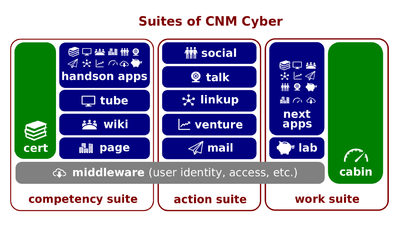Difference between revisions of "CNMCyber Appware"
(Created page with "400px|thumb|right|[[CNM Cyber]]How Apps Are Executed (hereinafter, the ''Lectio'') is the lesson part of the '''Soft behind CNM Cloud...") |
|||
| (39 intermediate revisions by 2 users not shown) | |||
| Line 1: | Line 1: | ||
| − | [[File:Cnm-digital.png|400px|thumb|right|[[ | + | [[File:Cnm-digital.png|400px|thumb|right|[[CNMCyber suite]]s]][[CNMCyber Appware]] (hereinafter, the ''Lectio'') is the [[lectio|lesson part]] of the '''[[CNM App Essentials]]''' [[lesson]] that introduces its participants to [[CNM app]]s. This ''lesson'' belongs to the [[Introduction to CNM Cloud]] session of [[EmployableU Concepts]]. |
| Line 5: | Line 5: | ||
The predecessor [[lectio]] is [[How Apps Are Built]]. | The predecessor [[lectio]] is [[How Apps Are Built]]. | ||
| − | === | + | ===Script=== |
| + | :Any [[CNM app]] becomes an [[end-user application]] when its [[software]] is installed on one of [[CNM Farms]]. The name of ''software'' starts with the name of the [[CNM app]] that belongs to [[CNM EndUser Apps]] that is followed by the ending <code>-ware</code>. For instance, [[Educaship MediaWiki]] powers [[CNM Wiki]], [[CNM Tubeware]] powers [[CNM Tube]], [[CNM Mailware]] powers [[CNM Mail]], etc. | ||
| + | |||
| + | :All the ''software'' is stored in the [[software repository]] of [[CNM Lab]]. [[HandsOnLab]] and [[LabNext]] also have copies of that ''repository''. | ||
| + | |||
| + | :[[Opplet]] utilizes the ''software'' using three [[deployment model]]s. | ||
| + | |||
| + | :The first model is traditional. The [[computing server]]s provide these ''apps'' with the [[operating system]], [[database]], support of [[programming language]]s, and [[web server]]s. | ||
| − | + | :In another model, [[CNM app]]s are executed as [[software container]]s. Besides the ''apps'', these ''containers'' include [[operating system]]s, so the ''containers'' don't rely on the one of the [[computing server]]. [[Container engine]]s of the [[CNM Farms]] provision the ''containers'' with everything they need to operate. | |
| − | : | ||
| − | : | + | :Initially, all [[CNM app]]s based on the ''computing servers'', but the number of ''containers'' is constantly growing. Eventually, those ''apps'' that rely on the servers for their computing functions will completely move to [[CNM Lab Farm]]. |
| − | : | + | :A new deployment model is being tested on the ''Cloud Next''. It is called [[serverless]]. Some part of this experimental cloud would be provisioned in the way that the new ''apps'' will not need to rely on any server at all. |
| − | : | + | ===Key terms=== |
| + | :[[CNM Cabinware]], [[Educaship Moodle]], [[Educaship GitLab]], [[CNM Linkupware]], [[CNM Mailware]], [[Educaship HumHub]], [[Educaship Jitsi]], [[CNM Tubeware]], [[Educaship MediaWiki]], [[software container]], [[serverless]] | ||
| − | : | + | ===Closing=== |
| + | :Is the concept of [[software container]]s explained well? (Yes/No/I'm not sure) | ||
| − | |||
| − | '''[[ | + | '''[[CNM Cloud Online]]''' is the successor [[lectio]]. |
==Questions== | ==Questions== | ||
| − | |||
| − | |||
| − | |||
| − | |||
| − | |||
===Placement entrance exam=== | ===Placement entrance exam=== | ||
Latest revision as of 16:03, 14 April 2024
CNMCyber Appware (hereinafter, the Lectio) is the lesson part of the CNM App Essentials lesson that introduces its participants to CNM apps. This lesson belongs to the Introduction to CNM Cloud session of EmployableU Concepts.
Content
The predecessor lectio is How Apps Are Built.
Script
- Any CNM app becomes an end-user application when its software is installed on one of CNM Farms. The name of software starts with the name of the CNM app that belongs to CNM EndUser Apps that is followed by the ending
-ware. For instance, Educaship MediaWiki powers CNM Wiki, CNM Tubeware powers CNM Tube, CNM Mailware powers CNM Mail, etc.
- All the software is stored in the software repository of CNM Lab. HandsOnLab and LabNext also have copies of that repository.
- Opplet utilizes the software using three deployment models.
- The first model is traditional. The computing servers provide these apps with the operating system, database, support of programming languages, and web servers.
- In another model, CNM apps are executed as software containers. Besides the apps, these containers include operating systems, so the containers don't rely on the one of the computing server. Container engines of the CNM Farms provision the containers with everything they need to operate.
- Initially, all CNM apps based on the computing servers, but the number of containers is constantly growing. Eventually, those apps that rely on the servers for their computing functions will completely move to CNM Lab Farm.
- A new deployment model is being tested on the Cloud Next. It is called serverless. Some part of this experimental cloud would be provisioned in the way that the new apps will not need to rely on any server at all.
Key terms
- CNM Cabinware, Educaship Moodle, Educaship GitLab, CNM Linkupware, CNM Mailware, Educaship HumHub, Educaship Jitsi, CNM Tubeware, Educaship MediaWiki, software container, serverless
Closing
- Is the concept of software containers explained well? (Yes/No/I'm not sure)
CNM Cloud Online is the successor lectio.
